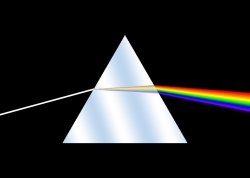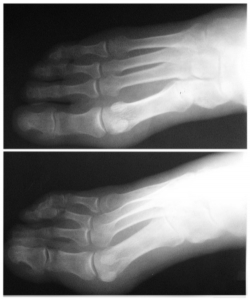Almost all of Earth's energy comes from the Sun. In fact, the sun can provide more energy in one hour than everyone on Earth could use in a whole year. All that energy moves in waves. Your eyes can see only a small part of that light, about as much as one raindrop in a bucket. But the light you cannot see packs lots of energy. It can give you a sunburn at the beach or help your doctor see a broken bone.

Let's shed some light on this subject.
ryszardwojdowski, CC BY-SA 3.0 , via Wikimedia Commons
Picture yourself at the beach. You stand at the end of a fishing pier and watch the waves travel past you. You look at your watch and count the waves: one, two, three waves pass you in a minute. You can time light waves in the same way, only they move far faster. Frequency is how often something happens. You may eat three times a day, while your best friend eats five times a day. When it comes to light, you can measure frequency by counting how many waves pass by in a second.
Different kinds of light waves have their own frequencies and amounts of energy. When you look at a light bulb, the light looks white, but it is really a mix of all the colors, each with its own frequency. The light your eyes can see, like all the colors of the rainbow, is less than 3% of the light the sun makes. That is like a few pails of sand at the beach. A range is a smaller part of a larger thing. The range of light we can see is very small compared to all the different light.

Prisms bend it like Beckham.
See page for author, CC SA 1.0 , via Wikimedia Commons
When sunlight shines through drops of water or a piece of glass called a prism, it breaks apart the white light into the colors of the rainbow. You see color when something soaks up light and bounces back one color. A blue shirt soaks up all the colors of light except blue and bounces the blue back to your eyes. There is a lot of light that you cannot see, but you can see all the colors of the rainbow. The frequencies of light you can see are called visible light.
All the different kinds of light, the light you can see and the light you cannot see, move at the same speed. It takes eight minutes for light to go from the Sun, which is 93 million miles away, to Earth. That is about 186,000 miles a second! Compare that to a car, which may drive 65 miles an hour on the freeway. All energy that moves in waves at the speed of light is part of the electromagnetic spectrum. This includes light you can see, x-rays, microwaves that cook your food, and ultraviolet light that can burn your skin at the beach.

If that's my foot, I've got a broken foot.
Alex Khimich, CC BY-SA 3.0 , via Wikimedia Commons
While an hour of sunlight could power the whole world for a year, you can see very little of it. The part of the electromagnetic spectrum that you can see is just a drop in the bucket. Still, for most people, your eyes are your strongest sense. Without that light, you could not learn about the world around you. You also might not be able to look at a broken bone or turn the TV off or on with a remote. Light gives us power in more ways than one!
References:
Allday, Jonathan. Light and Sound. New York: Oxford University Press, 2002. Print. The Young Oxford Library of Science, vol. 6.
Abromowitz, Mortimer, Thomas J. Fellers and Michael W. Davidson.
"The Nature of Electromagnetic Radiation." Molecular
Expression' Optical Microscopy Primer: Light and Color. Optical
Microscopy Division. National High Magnetic Field Laboratory,
2005.
<http://micro.magnet.fsu.edu/primer/lightandcolor/electromagintro.html>
"Electromagnetic
Spectrum." World of Physics. Gale, 2010. Gale
Science In Context.
<http://ic.galegroup.com/ic/scic/ReferenceDetailsPage/DocumentToolsPortletWindow?displayGroupName=Reference&action=2&catId=&documentId=GALE|CV2434500140&userGroupName=dc_demo&zid=7ec5a39299473104148c2a22c983d31b>
"Electromagnetic spectrum." U*X*L
Encyclopedia of Science. U*X*L, 2007. Gale Science In
Context.
<http://ic.galegroup.com/ic/scic/ReferenceDetailsPage/DocumentToolsPortletWindow?displayGroupName=Reference&action=2&catId=&documentId=GALE%7CCV2644300393&source=Bookmark&u=dc_demo&jsid=7dac85bfc50182a41a408f34e8f23563>
Fowler,
Michael. "The Speed of Light." Galileo and Einstein.
University of Virginia Physics Department.
<http://galileoandeinstein.physics.virginia.edu/lectures/spedlite.html>
Hamilton, Gina L. Light. New York: Weigl Publishers Inc., 2009. Print. Science Q & A.
"On the Move." Energy. Chris Woodford. London: Dorling Kindersley, 2007. 32-35. See for Yourself. Gale Virtual Reference Library. Web. 13 Sep. 2012.
Smythe, William R. "Electromagnetic radiation." AccessScience. McGraw-Hill Companies, 2008. Web. 12 Sep. 2012.